|
- Catalog (in stock)
- Back-Catalog
- Mail Order
- Online Order
- Sounds
- Instruments
- Projects
- History Face
- ten years 87-97
- Review Face
- our friends
- Albis Face
- Albis - Photos
- Albis Work
- Links
- Home
- Contact
- Profil YouTube
- Overton Network
P & C December 1998
- Face Music / Albi
- last update 03-2016
|
text available in German
Traditional Russian music is predominantly heterophonic: the same melody is distributed among different voice parts, with one leading voice, mostly in a middle register. The lead singer (sapevála) determines the course of the melody, and the other voices come in later. This heterophonic group singing is often embellished by an independent voice in a very high register (podgolóssok).
The principle of heterophony allows the principal voice much space for improvisation, continuous variation, and embellishment. It has also an effect on the lyrics, in so far as single words or phrases are lengthened by means of vocalisms or enlarged with additional syllables. This type of choral singing can be frequently found in whole Russia, the Siberian area of those being re-settled as well as in Central Ukraine, in the steppes and in the Eastern Ukraine, where also lyrical ballads are very popular.
There is a rich repertory of many famous Cossack songs and traditional dances. This music has its roots in a centuries old oral tradition of bylina (epics, heroic narrative poetry) and dumas, that is long lyrical ballads glorifying the exploits of the Cossacks.
Festivities in the village community and in the families offered opportunities for singing. Apart from dance songs, we can also found so-called Chorowódy (round dances), who are integral part of certain holidays in the calendar. Bridal courtship, the bride leaving her parents and other wedding songs find their muscial expression in a whole cycle with such round dances.
According to the rather different origin of the settlers, the traditional music of the Russian population (the inhabitants of Russia) in the Southern Altai in the Siberian area is very manifold. There can be found a diversity of dialects and forms who have been mixed and developed, apart from the Cossacks whose origin is also a rather diverse one (South Russian from the Don and den Donez in the Ukraine, respectively, the so-called Zaporozhian Cossacks).
In the Altai there have settled the Old Believers who opposed the reforms of the Orthodox rites initiated by the Patriarch Nikon and had been persecuted since 1667 by the Russian Orthodox Church as heretics. As these heretics were primarily persons deported in the name of Catherine II from Belarus and the Ukraine, former subjects of the Polish-Lithuanian kingdom, they have been called Poles ever since. Also Catholics from this area have found a refuge here.
Traditional folk music is the Russians' life and soul. The songs tell about the history of this people, describe the landscape, the folk's character and the people's qualities. They also speak about the ethics and rules of social life. These songs are a real treasure that has been preserved up to date. They can be classified in various genres as well as in ritual and non-ritual songs.
- Ritual songs:
1. Incantation
|
Healing songs, songs to influence the weather |
2. Laments
3. Ritual songs of the folk calender
|
- the winter cycle (Christmas): There are congratulatory and laudatory songs to celebrate Christmas (kolyadky) and the New Year (shchedryvky). Singing these songs, young people go an a ceremonial tour visiting the local households and wishing the houseowners prosperity. |
|
- the spring cycle: The songs of this cycle are called vesnyanky and hayivky and are sung by girls in a circle-dance. There is an element of magic in the ritual songs calling for rain. In the early spring (vesna), the vesnyanky (songs invoking the season) are sung, as a rule, in an open place at the outskirts of a village. Singing games and circle-dances that are called haivky (spring games) belong to this cycle. |
|
- the festival of threshing the grain. |
|
- pre-harvest: Into this period fall the celebrations of Ivan Kupalo (kupal'sky = baptizing) or St John the Baptist and St Peter (petrivky). The heyday of the summer festivities is the celebration of Ivan Kupalo, John the Baptist's Day. This brings to a close the lyrical spring theme of couplets*. The Kupalo ritual closely resembles in meaning and character the "petrivky" songs, performed during a period of two or three weeks before "St Peter's Day" (29th of June). |
|
- *Couplet singing: historical songs, psalms, playing in bands and playing the kobza (plucked lute) or lyric songs with a strophic structure, kolyadky (hymns or songs of praise), marches and other ritual folk-tunes in the form of the singing-dancing. |
|
- harvest: ritual work songs at the beginning of harvest (zazhynky) and the celebration at its completion (obzhynky). Another part of the summer cycle is celebrated in work songs sung during mowing and harvesting. These songs bring the summer period to an end.
Their original magic meaning was later replaced by social motifs, i.g. the reapers' hard labour, the relations with their employer or the demands for better wages.
|
|
- general holidays, religious songs sung in the village on the occasion of processions or at home. |
4. Wedding songs
|
- These songs explain what is happening at any given moment during the wedding ceremony; the function of these songs is similiar to incantations - the main theme is about the festive, joyful side of the ritual, and the songs contain also parts of congratulations, or they may even be comic. There is a second sort of wedding songs that are sung at the parting of the bride from the paternal home. They are more lyrical and dramatic and have a looser structure. The wedding party is usually accompanied by a village instrumental trio. The main instruments of this ensemble are the fiddle, the bayan (accordion) and the tambourin, and there is often also a pipe. |
|
- The non-ritual wedding songs are sung for entertainment at appropriate times during the celebrations that usually last for one week. |
5. Work songs
|
- women work songs
These songs are sung during or after work being accomplished together. In the winter, these songs are sung when the women meet to spin.
|
|
- work songs when working together
These songs are also sung in other seasons, according to the type of work performed collectively (for example, field work, digging a well, building a house, reparing the streets, etc.).
|
|
- work songs after the completion of field work
If a farmer has to much field work to accomplish, he asks his neighbours for help. After completion of this work, he invites his neighbours to dinner; afterwards they sing songs with texts often including secular sayings and quotes.
|
- Non-ritual songs:
- folk epics (duma) or ballads; historical and political songs, work and lyric songs.
The dumy are lengthy lyrical compositions of epic character based on principles of musical recitation. The rhythms of the ballad's lyrics are not restricted to stable metrorhythmic schemas and determine the improvised style of the musical recitation on the basis of variations of typical phrases and verses. The dumy were performed by a soloist called kobzar, because he usually accompanied himself on the kobza (plucked lute), sometimes also on the lira. He sang about historical events and elements of daily life. The kobzary [plural for kobza], as a rule, were blind.
- Lyric songs can be love songs, songs that tell about family life, or lullabies.
- Instrumental music
- Instrumental folk music takes various forms: solo performing on the pipe, violin, bayan, etc. and ensemble playing. Pre-Christians used typical medieval European musical instruments, including the gùsli (wood-zither), svirel (a woodwind instrument equivalent to the shepard flute); gudok (similar to a fiddle, rebec) and also horns, as well as schamanic accessories like drums, small bells, tambourines, and noisemakers. Such instruments were typically used during rites, entertainment, court ceremonies, and probably in pagan temples. Folk musicians, who played these instruments and organized weddings in the Ukraine and later in Russia, Southern Altai (Siberia) were called skomorokhi. The musicians also engaged in acrobatics, puppet shows, and juggling, perpetuating the traditional medieval popular culture. The skomorokhi culture, however, which had developed in Russia over such a long period of time, was preserved in folklore.
Folk instruments are not very traditional among the Russians in the Altai region. The Ensemble Pesnochorki has completed them according to the song texts and analogue to other Russian regions: Apart from gudók (folk fiddle - rebec), bayan (button accordion), shaléjka (horn pipe- shawm) or the tubes made from wood (kugikly), played like a pan flute by blowing into it, gúsli (a small wooden zither). Drums, tambourine and spoon are used as percussion instruments.
- Instruments in Siberia


|
- Schawm - Schaléjka - Zhaleika
- wind-instrument
(folk clarinet or hornpipe)
It has a single reed which may be covered by a mouthpiece (or "wind-cap"). There is a wooden barrel with finger holes and a flared bell. It can be made of various natural or man-made materials; cow horn bells are common, but all-wood and even birch bark zhaleikas do exist, too. The zhalaika has a diatonic tuning that comes in various keys (G, A, F) and in soprano (i.e. "normal"), alto, and even piccolo forms. They can be tuned by adjusting the reeds. The instrument is normally tuned to the mixolydian mode (which means, in the key of G you get all naturals, no accidentals), and you only get one octave's worth of notes. You can also get the final non-diminished 7th tone with alternate fingering.
.
As a minimization, it is also called the Siberian saxophone.
|

|
- Horn trumpet - Vladimir horn - Wladimirski Rozhok
- wind-instrument
(trumpet horn - Vladimir horn)
This is a wooden horn with trumpet-style mouthpiece and finger holes. It has historically been most common in the northeast-central parts of European Russia near Vladimir (hence the name "Vladimir horn") and Varoslavl.
The basic diatonic set of rozhki would include one or two sopranos in G, an alto in C, and a tenor (an octave below the soprano) in G. Besides the diatonic instruments, there are now chromatic rozhki. The rozhok can play its first octave in pure tones, then by overblowing you can go into further (higher) register. So, unlike the previous instruments, you get more than an octave.
|
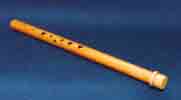

|
- Svirel
- wind instrument
(reed pipe, pennywhistle)
The group of flute-like reed wind instruments is known as svirel in the Russian language. The use of this denomination has led to great confusion as a distinction between the different types of folk wind instruments has been turned into a rather difficult challenge because of this. This is the result of the fact that the meaning of the word svirel, strictly speaking, only applies to a non-recorder.
These instruments do not have a mouthpiece. They consist of a hollow pipe with six up to ten holes. The pipe itself may be made of any kind of material, also metal and plastics. Usually the numer of holes is six, but additional holes make it possible that chromatic notes may be easily created with the instrument. The important difference lies in the end of the pipe where the player has to strike his/her breath against the tube wall. This creates a similar tone like that of the flute.
|
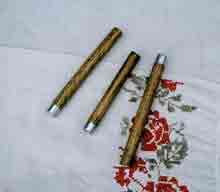
|
- Kugikly
- wind-instrument
(tubular wood block, reed pipe - used similar like the panpipe)
Kugikly are panpipes. They can have anywhere from 1 to 8 pipes, though 2-5 pipes glued together seems to be a common set. They seem to be most often played by groups of women.
Kouguikly autant d'onomatropees
|

|
- Okarina - Sistulka
- wind-instrument
Vessel flute, also named cuckoo as this instrument can imitate birdcalls.
Children like to play with it. Ocarina - vessel flute, used to imitate birdcalls.
The ocarina belongs to the group of whistle instruments and in fact is a sophisticated svystun (whistle). These instruments are usually made of clay with seven or eight and sometimes ten finger holes.
|
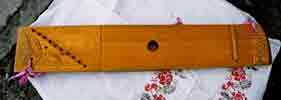 |
- Gùsli - Woodzither - Psaltery - Lute
- string-instrument
(small wood zither - folk psaltery)
The word husli was, in the times of Kievan Rus, the generic word for a string instrument. Later the word became associated with a psaltery-like instrument. The word is derived from the early Slavic word "gosl", which meant "string" and can be found in other Slavic languages. In the Balkan, "gusle" denotes a one-stringed fiddle. In Western Ukraine and in Belarus it is often used to denote a fiddle and sometimes a ducted flute. The husli influenced the introduction of treble strings on the bandura, and because of this, the bandura replaced the husli. In the 19th century it was played primarily by townsfolk and clergy. The instrument had 11 to 36 diatonically tuned strings made from tendons, nylon or metal, and it was made in various sizes.
This instrument is plucked rather than hammered. In that functional sense, it has more resemblance with a harp, or better yet a zither (or autoharp), than with a hammered dulcimer or cimbalom.
The gùsli is most often played upright, with the edge of the long and down on the knees; the left hand (over the runing pins and bridge) damps the strings not in the chord / melody, while the right hand strums or plucks the strings. The gùsli has approached a certain standardization (primo, alt or bass sizes). The diatonic tuning of the gùsli ranges from B below middle C to C# two octaves above middle C. The keys of A, Bm, C#m, D, E, F#m, and G#m are available. The tuning was standardised to optimise its use with the balalaika and dömbra. It is very difficult to use a gùsli so tuned with Russian folk winds such as the zhalaika and rozhok; these instruments (especially the rozhok) are tuned in G and C. The solution has apparently been to add sharping levers. These are called "mechanical" in Russian.
The gùsli is mentioned in the epic by an eleventh-century bard.
|
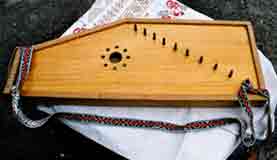
|
- Gùsli - Woodzither - Pslatery
- string-instrument
(greater wood zither - folk psaltery) |

|
- Balalaika
- string-instrument
(Russian lute)
The varied family of Central Asian lutes is a large one, and one of the most popular and best known is the balalaika, with its unique triangular body shape. Developed from non-standardised folk lutes in the late 18th century into a whole family of instruments with standard tunings, the balalaika has become one of the most important plucked stringed instruments in Eastern Europe. A very intricate, virtuousic repertoire has elevated the balalaika to a level of a classical instrument, and is taught as such, with written music, transcriptions of other works, and its own special music composed for it.
The most common size is the prima balalaika, tuned E,E,A, played with the fingers by means of a wide variety of techniques. It is strung with a metal A and 2 nylon E's, and the concert model has a range of 2 and a half chromatic octaves. One feature is the offset 2nd string, closer to the 3rd string than the 1st, facilitating the use of the left hand thumb, a significant part of the playing technique.
The second balalaika is a bit larger and is tuned A,A,D; the alto larger yet and tuned an octave below the prima. Bass balalaikas are tuned E,A,D and contrabass E,A,D an octave lower. These may be played with a leather pick.
Balalaikas are played solo or in ensembles, in particular the balalaika orchestre which in addition to all sizes of balalaika includes the dömbra, a related round-bodied long neck lute tuned in 4ths and played with a pick, the bayan (Russian chromatic button accordion) tambourine, and sometimes various reed pipes and flutes.
|
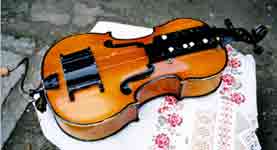
|
- - Hurdy-gurdy - Lyra - Kolesnaja Lira
- string-instrument
Die Drehleier ist
|
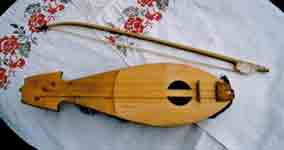 |
- Rebec - Fiddle - Gudòk
- string-instrument
(folk fiddle)
The rebec is a string instrument, the pear-shaped body together wih neck and head of which is fabricated from a single piece of wood. In the Middle Ages, it was usually produced three-sided in different sizes and forms, and it was, apart from the "big fiddle" (fiddle), also called small fiddle. In contrast to the fiddle, the rebec is tuned in fifths.
It was the most popular instrument in the Middle Ages. It is depicted in the hands of vagabonds, musicians, and angels. This instrument was often played on the occasion of local festivities and feasts, such as at the court of princes and kings. It has steadily been refined, and from the original spade-like form of the 8th century there has developed the oval form, which is nowadays known for its retracted strings. From the late Middle Ages on, there has developed a large number of string instruments played with a bow, such as, for example, violins, violas, cellos, etc., which probably have their origin with the fiddle of the Middle Ages.
|
 |
- Violin - Skrypka
- string-instrument
The traditional fiddle has now been replaced by the standard violin, the folk tradition of playing the instrument, however, is still alive. The fiddle is a prominent instrument at weddings and usually performs dance music. Fiddlers play also solo for entertainment. Many traditional fiddles were very crude in construction, some being just boards with strings attached.
|
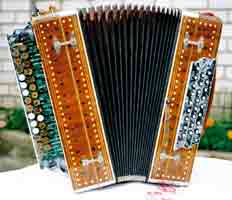
|
- Bayan - Accordion
(chromatic button accordion)
Originally, the bayan came from the Ukraine to Russia. Today it is very frequently played, and in the meantime has substituted many very traditional folk instruments. The button accordion initially came from Germany in the 1830ies to Russia.
With the button accordion all notes of the chromatic scale may be played, and the buttons are arranged in a way so that each key may be played without changing the chord. The plates or reeds, which are rather different in form and material, make different tones for a single note possible, and as it is the case with an organ, with the bayan it is also possible, due to a system of different registers, to distribute air in a way enabling variation of timbre. These registers are manipulated by means of sixteen keys situated above the right keyboard, and the register switches used most of the time may also be operated by the chin, by means of seven buttons situated on top of the instrument.
|
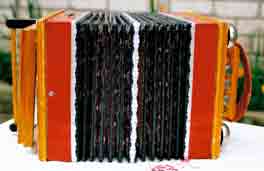
|
- Saratovskaja Harmon - Accordion
(little button accordion)
|

|
- Tambourin - Buben
- perc instrument
Tambourines in general are handheld instruments with a round wooden frame and parchment or skin heads; metal disks or bells (called jingles) are inserted into the wooden rim. By striking the head of the tambourine or by shaking it, you set the jingles in motion. |
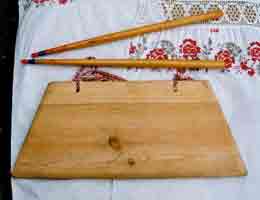
|
- Wooden board drum - Pastuchi Baraban
- perc instrument |
|
- Lozhki - Spoons
- perc instrument
The Russian style of (wooden) spoon playing is rather a lot different from either tradition.
With two spoons in one hand you can "clack" them. With the third spoon in your other hand you can "whap-whock-clack" polyrhythms.
|
English translation and revision by Hermelinde Steiner.
|
